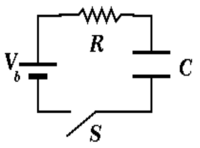Difference between revisions of "Forest RC circuits"
| Line 1: | Line 1: | ||
| + | The circuit diagram below defines a common circuit known as an RC circuit. The circuit involves only a capacitor and a resistor. The resistors role is to impede (resist) the flow of current (iR) and the capacitors role is to store charge (q/C). | ||
| + | |||
[[Image:RC_Circuit.png | 200 px]] | [[Image:RC_Circuit.png | 200 px]] | ||
| + | |||
| + | Pumping air into a bicycle tire is a fair analogy of this circuits properties. You are the battery, the pump you push is the resistor and the tire is the capacitor. As a battery you push electrons through the resistor (pump) and into the capacitor. The resistor (pump) resists the flow of the electrons into the capacitor. As the capacitor starts to charge up (tire fills with air) it becomes harder to push electrons onto the capacitors plates (add air to the tire). Now the capacitor (tire) starts to resist you pumping making it harder to charge up. | ||
Revision as of 16:41, 3 April 2008
The circuit diagram below defines a common circuit known as an RC circuit. The circuit involves only a capacitor and a resistor. The resistors role is to impede (resist) the flow of current (iR) and the capacitors role is to store charge (q/C).
Pumping air into a bicycle tire is a fair analogy of this circuits properties. You are the battery, the pump you push is the resistor and the tire is the capacitor. As a battery you push electrons through the resistor (pump) and into the capacitor. The resistor (pump) resists the flow of the electrons into the capacitor. As the capacitor starts to charge up (tire fills with air) it becomes harder to push electrons onto the capacitors plates (add air to the tire). Now the capacitor (tire) starts to resist you pumping making it harder to charge up.
